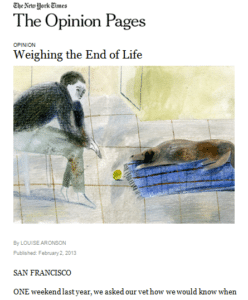The Op-Ed is an interesting beast, not least because that shorthand is often thought to mean “opinion or editorial” when in fact it means “opposite the editorial page” (on that perhaps dying artifact known as a newspaper), and as it turns out the two definitions are about equally accurate in these days of electronic readers.

One of the great things about op-eds is that anyone can write one (unlike editorials which are written by the newspaper’s staff). Of course, nothing’s really that simple, and writing an op-ed is easier than writing a good op-ed, which in turn is easier than getting even a good one accepted for publication. Most papers get hundreds or thousands of submissions for a handful of spots.
So can you increase your chances of success? And why should you listen to me?
I’m no expert but I have had 3 op-eds published, two in 1999 in the San Francisco Chronicle – The Fear of Losing Who We Are and A City Full of The Hidden Homebound – and one today in the New York Times, Weighing the End of Life.

All three drew on my expertise as a geriatrician, though the first combined that with my passion for reading, the second with my concern for the patients I met as a housecalls doctor, and the third with my love for my dog, Byron.

“Byron”
1997 – 2012
So what do you need to write an op-ed? At the very least, it’s important to have:
- A topic of interest to others
- Some expertise (knowledge and/or experience) in that topic
- A great story to tell and/or an original and interesting argument
- An effective way of communicating 1-3

And if you’d like to learn more about writing op-eds, you’re in luck. The perfect resource already exists – Go to the Op-Ed Project to find:
- submission information for over 100 top outlets
- how to create world changing arguments
- basic op-ed structure; tips for writing publication worthy op-eds
- how to write ledes and news hooks
- how to pitch your op-ed idea
- and seminars to learn more.
Happy writing!
